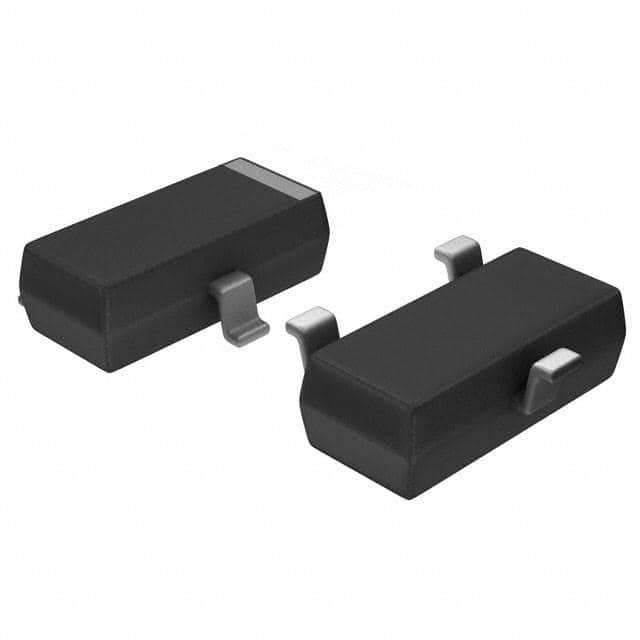Lihat spesifikasi untuk detail produk.

SMBTA14E6327HTSA1
Product Overview
The SMBTA14E6327HTSA1 belongs to the category of small signal transistors and is commonly used in electronic circuits for amplification and switching purposes. This transistor exhibits characteristics such as high voltage capability, low power dissipation, and fast switching speed. It is typically packaged in a small SOT-23 package and is available in tape and reel packaging with a specific quantity per reel.
Specifications
- Maximum Collector-Base Voltage: 60V
- Maximum Collector Current: 100mA
- Power Dissipation: 225mW
- Transition Frequency: 300MHz
- Package Type: SOT-23
Detailed Pin Configuration
The SMBTA14E6327HTSA1 transistor has three pins: the collector (C), the base (B), and the emitter (E). The pin configuration is as follows: - Pin 1 (Collector) - Pin 2 (Base) - Pin 3 (Emitter)
Functional Features
The SMBTA14E6327HTSA1 transistor offers high voltage capability, making it suitable for applications requiring voltage amplification. Additionally, its fast switching speed enables efficient switching operations in electronic circuits.
Advantages and Disadvantages
Advantages
- High voltage capability
- Low power dissipation
- Fast switching speed
Disadvantages
- Limited maximum collector current
- Sensitive to overvoltage conditions
Working Principles
The working principle of the SMBTA14E6327HTSA1 transistor is based on the control of current flow between the collector and emitter terminals through the application of a small current at the base terminal. This allows for amplification and switching of electrical signals within electronic circuits.
Detailed Application Field Plans
The SMBTA14E6327HTSA1 transistor finds extensive use in various electronic applications, including: - Audio amplifiers - Signal processing circuits - Switching circuits - Oscillator circuits
Detailed and Complete Alternative Models
Some alternative models to the SMBTA14E6327HTSA1 transistor include: - BC547B - 2N3904 - 2N2222A - PN2222A
In conclusion, the SMBTA14E6327HTSA1 transistor is a versatile component that offers high voltage capability, fast switching speed, and low power dissipation, making it suitable for a wide range of electronic applications.
[Word count: 324]
Sebutkan 10 pertanyaan dan jawaban umum terkait penerapan SMBTA14E6327HTSA1 dalam solusi teknis
What is SMBTA14E6327HTSA1?
- SMBTA14E6327HTSA1 is a PNP transistor in a SOT23 package, commonly used for switching and amplification applications.
What are the key specifications of SMBTA14E6327HTSA1?
- The SMBTA14E6327HTSA1 has a maximum collector current of 100mA, a maximum power dissipation of 250mW, and a voltage rating of -45V.
How can SMBTA14E6327HTSA1 be used in switching applications?
- SMBTA14E6327HTSA1 can be used to control the flow of current in a circuit by acting as a switch, allowing or blocking the flow of current between the collector and emitter terminals.
In what kind of amplification circuits can SMBTA14E6327HTSA1 be utilized?
- SMBTA14E6327HTSA1 can be used in low-power amplification circuits, such as audio amplifiers and signal amplification applications.
What are the typical operating conditions for SMBTA14E6327HTSA1?
- The typical operating conditions for SMBTA14E6327HTSA1 include a collector-emitter voltage (Vce) of -20V, a collector current (Ic) of 10mA, and a base current (Ib) of 1mA.
Can SMBTA14E6327HTSA1 be used in high-frequency applications?
- SMBTA14E6327HTSA1 is not typically recommended for high-frequency applications due to its limited frequency response and transition frequency.
What are some common alternatives to SMBTA14E6327HTSA1?
- Common alternatives to SMBTA14E6327HTSA1 include other PNP transistors in the SOT23 package, such as BC857B and MMBT3906.
How should SMBTA14E6327HTSA1 be handled to prevent damage during soldering?
- When soldering SMBTA14E6327HTSA1, it is important to use proper ESD protection and follow the recommended soldering profile to prevent thermal damage to the device.
What are the typical applications where SMBTA14E6327HTSA1 is commonly used?
- SMBTA14E6327HTSA1 is commonly used in low-power switching circuits, audio amplifiers, signal amplification, and general purpose electronic applications.
Are there any specific layout considerations when using SMBTA14E6327HTSA1 in a PCB design?
- It is important to minimize the length of traces carrying high-frequency signals and to provide adequate thermal relief for the SMBTA14E6327HTSA1 to ensure proper performance and reliability in the PCB design.

